

Note please: these images are arranged on this page as they appear on the facade from left to right. | ||
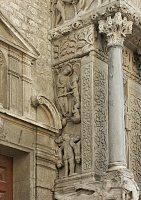
|
The weighing of the soulsThis scene appears on the far left corner. The angel weighing the souls may be Michael. The sequence of scenes on this corner is shown in the column below. Above the scene with the balance is the scene of the temptation of Adam and Eve in the Garden of Eden. Without this event in biblical history, there would be no sin and thus no need for the last judgment. Note also that the angels trumpeting the last judgment appear in the voussoirs of the tympanum. | |
Right: Hercules, a pagan hero--prefiguration of ChristStoddard cites F. Benoit for the identification of the the nude figure wearing a lion's skin draped around his body. He also points out a second Hercules above (below the weighing scene)--a nude figure holding the dwarf Ceropes (Stoddard 287). These are examples of the medieval mind using classical mythology to further the ethical views of Christianity. | ||
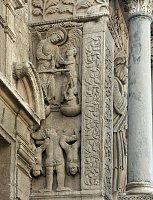
|

|
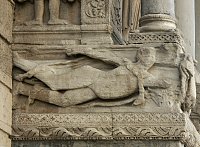
|
The savedHere on the left side (Christ's right) the saved souls are lined up. Like much medieval figural sculpture, the figures are somewhat repetitive and here depicted in flat, shallow relief. They are balanced on the right side of the facade (that is, Christ's left--sinister side) by the damned. |
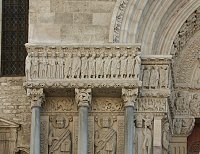
| |
| This row of figures is led around the corner by an angel who offers a soul to the three seated figures who hold more souls in their laps. This is an expansion of the usual "lap of Abraham" theme, found in so many medieval church facades. (See, for example, the central portal of the south transept at Chartres.) I believe the three seated figures represent not only Abraham but also Isaac and Jacob. Extra-biblical sources often play prominent roles in medieval symbolism. The Old Testament Apocrypha says, "After our death in this fashion Abraham, Isaac, and Jacob will receive us and all our forefathers will praise us" (4 Maccabees 13:17). Underneath these seated figures coffins appear to be opening up with small figures emerging. | ||

|
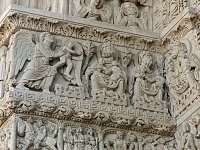
|

|
The Damned on the right side--or Christ's leftThe damned are here (center image) denied entrance at the "door" of Heaven. Note their expressions of dismay. The armed angel is probably Michael, the warrior archangel. The seated figure, lined up with the apostles on the lintel of the tympanum, has been identified by R. Hamann (cited in Stoddard) as "Lazarus in Heaven" or "Lazarus raised to sainthood" (Stoddard 284). The sequence of enchained damned figures is symmetrical with the row on the left hand side, although they march to the right to Hell. Flames lick at their feet and legs. | ||
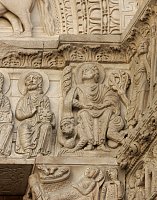
|
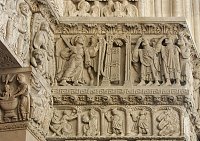
|
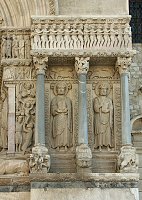
|
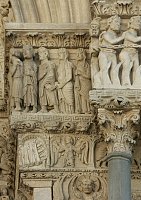
|

|
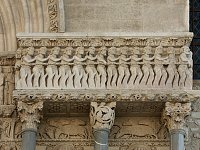
|
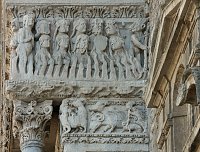
|
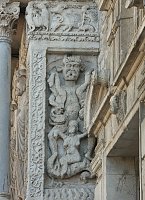
|
The far right cornerA demon is the last figure depicted in the line-up. Since there are two rows of figures, no longer enchained, it appears as if the lower row might be seated. The demon appears to be holding a rod--or an oar? Is this Charon fording the damned across the Styx? In the eroded panel below, a grotesque demon holds two souls upside down and a nude female sits on a beast (dragon, lizard?). She is usually interpreted as a symbol of luxury. |
 Go to Saint Trophime Index.
Go to Saint Trophime Index.
 Click here to return to index of art historical sites.
Click here to return to index of art historical sites.
 Click here to return to index of artists and architects.
Click here to return to index of artists and architects.
 Click here to return to chronological index.
Click here to return to chronological index.
 Click here to see the home page of Bluffton University.
Click here to see the home page of Bluffton University.

